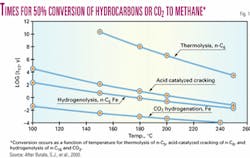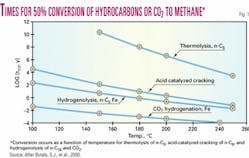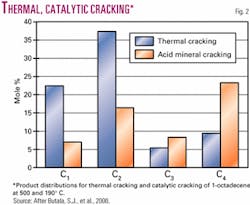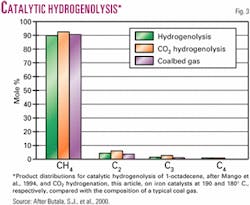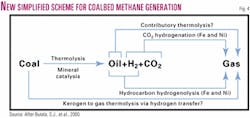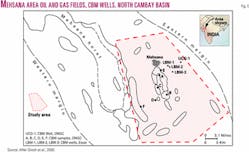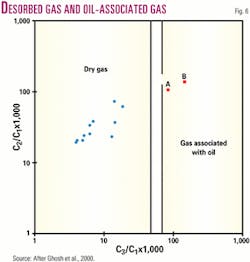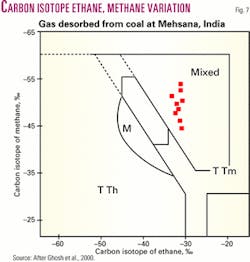The current geochemical view is that hydrocarbons generated from organic matter disseminated in fine-grained sedimentary rocks and coals are controlled primarily by temperature and duration of heating (geologic time).
Recently, this view has been questioned by several investigations1-4 with respect to formation of oil, natural gas, and coalbed methane. They showed by pyrolysis experiments and kinetic analysis that the temperature-controlled thermal cracking process is too slow to account for the known volumes of gas and CBM and that the resulting composition of gas is vastly different from that obtained in nature.
On the other hand, these studies showed that mineral catalysis/transient metal catalysis is a more geologically realistic pathway for the formation of CBM and natural gas. Artificial coal maturation results indicate that raw coals generate more hydrocarbon gas than demineralized coal.
As for natural gas, N-alkenes, hydrogen, and carbonaceous sedimentary rock containing moderately high concentrations of transition-metals are experimentally shown to react under mild conditions (~200°C.) to generate a light hydrocarbon product indistinguishable from natural gas in molecular and carbon isotope composition.
The reaction is catalytic, generally natural gas in the laboratory for the first time.3 Transition metal oxides (V, Fe, Co, and Ni) also catalytically decompose crude oil to a gas indistinguishable from natural gas. This reaction of crude oil to yield natural gas is "unprecedented and unexpectedly robust with conversion 100% in days at 175°C."5
As a hypothesis, the presence or absence of oil at great depths could well be linked to the presence or absence of transition metal catalysts that can destabilize crude oil to produce gas. It may be noted that natural deposits of petroleum and gas do not contain cycloalkane and isoalkane contents indicative of progressive thermal decomposition to gas.6
Mineral catalysis
However, investigators are not yet ready to discard thermal cracking in favor of mineral/metal catalysis as the major pathway for natural gas and CBM formation. This is because of the question whether mineral catalysis is really at work in nature.
Here we shall give a field evidence for metal-catalyzed formation of natural gas that has been pointed out4 and show that low rank coals buried in the Cambay basin in India provide a satisfactory field demonstration of the mineral catalysis pathway.
These coals have certain characteristics that strongly suggest that much of the CBM in the area was formed by mineral catalysis rather than by thermal cracking, the balance gas being of biogenic origin.
Direct CBM field evidence for mineral catalysis at work is infeasible. Catalytic action merely speeds up ongoing slow action. It does not change product composition or structure. Therefore CBM formed by thermolysis and by mineral catalysis would be ordinarily indistinguishable until chemical "fingerprints" to differentiate can be obtained.
Accordingly, any field evidence at this time has to be indirect and circumstantial. The author believes that these two field demonstration cases lend some credibility to the excellent experimental results.
There could be more such cases if only one looks for them.
From an exploration angle, one noteworthy point that emanates from these results is: It would seem to be more pertinent to look for transition metal oxides (V, Fe, Co, Ni) in source rocks for oil and gas and to look for reducing mineral catalysts like Fe (oxide) in coals instead of rock maturity and time-temperature history as currently considered. This is because catalytic process is believed to be a critical factor in generation of CBM and natural gas, as shown in succeeding sections.
Recent review
A comprehensive review of mechanisms and kinetics of reactions leading to natural gas formation during coal maturation with 177 references was published recently.1 Its salient findings are as follows:
- At typical coalbed temperatures, methane formation from hydrocarbon thermolysis reactions are several orders too slow to produce the discovered CBM gas reserves as compared to methane formation by CO2 methanation or liquid hydrocarbon hydrogenation on reduced iron-mineral catalysts (Fig. 1).
- The composition of hydrocarbon products in thermolysis reactions is very different from CBM composition (Fig. 2). But the gas composition from mineral-catalyzed hydrogenolysis of liquid hydrocarbons and CO2 hydrogenation are closely similar to typical CBM gas composition (Fig. 3).
- Significant fractions of the iron required for catalytic action are present in a number of coals as reducible oxides, clays, or carbonates. This suggests that using analyses of coal minerals like iron-oxide can be a good tool for CBM gas resource exploration like thermal maturity parameters used at present. Worldwide, iron is an important inorganic element of coal.
- The schematic diagram of CBM generation model (Fig. 4) assumes that about 10 wt % of the carbon in the coal is converted to methane during maturation.
Mehsana coals
The low-rank coals in the Mehsana area of the North Cambay basin (Fig. 5) provide a good field case to demonstrate in nature the formation of CBM by mineral-catalysis. These coals (mainly lignites) occur in large quantities at depths of 700 m to 1,600 m.
Two major coal seams were deposited in the swampy delta during a major regressive phase in the basin's postrift stage. The upper seam is 5 m to 45 m thick. The lower seam is 10 m to 60 m thick.
Three investigations of CBM in the area were done at different periods.
The first was done by Oil & Natural Gas Commission (ONGC) in 1986 as part of the studies on underground coal gasification (unpublished).7 A well UCG-1 was drilled and 16 m of main coal seam cored at a depth of 855 m besides other seams above and below.
The second investigation (carried out under the author's supervision) was done in 1992-93 by Essar Oil Ltd.8 Essar drilled 3 CBM wells near Mehsana (Fig. 5).
The main coal seam was cored at depths of about 1,350 m.
The third investigation was done by ONGC during 1998-2000 by collecting CBM gas samples from 6 wells in the Sobhasan oilfield area near Mehsana (Fig. 5).
Coal properties
The salient properties of the low rank coals obtained in these investigations are as follows. The coals are mostly brownish black to black and moderately compact. In the UCG-1 well abundant oil droplets and globules showing greenish yellow fluorescence were noted in the coal core.
ONGC described these coals as being lignito-bituminous, similar to the Tertiary coals of Indonesia and the Gippsland basin in Australia. Average vitrinite reflectance ranges from 0.30% in UCG-1 well to 0.36% in LBM wells.
In UCG-1, coals have about 82% vitrinite, 16% exinite, and 2% inertinite. In the LBM wells drilled under the author's supervision, coals have about 91% vitrinite, 4% exinite, and 5% inertinite.
Gas contents obtained by desorption of coal cores are 3-6 cu m/tonne in UCG wells.7 In the deeper coals of the LBM wells, the gas content range is 6-8.85 cu m/tonne.9 The gross calorific value is 7,000-7,400 K-cal/kg.
Hydrogen content is rather high at 5-6% on a dry, ash-free basis. Moisture content is 8-12%, well below the normal values for lignites. But density at 1.2 is as it should be for lignites.
Measured gas contents are abnormally high for these low rank coals with vitrinite reflectance of 0.30-0.36%. Lignites can normally be expected to contain up to 2.5 cu m/tonne of CBM. It is biogenic gas since thermogenic gas formation begins only when vitrinite reflectance reaches the value of 0.6%. Therefore 3.5-6 cu m/tonne of desorbed gas remain to be explained for its origin.
Since thermolysis is ruled out as a possible cause of the unexplained portion of gas content, we consider migration of gas and mineral catalysis as possible mechanisms to account for this portion of gas content.
Other factors
But migration is also unlikely in the geological conditions of the CBM area. This is because these coals are enclosed in Cambay shales which are considered to be source rocks for oil rather than gas in the Mehsana area.10
The area has some oilfields but no gasfield. Moreover, ONGC's investigations9 showed that none of the CBM gas samples obtained in the Sobhasan oilfield area are related to oil generation (Fig. 6) and that methane in coal seams is of mixed origin (Fig. 7).
The crossplot of carbon isotope value of methane and ethane from desorbed gas of some samples indicates early thermogenic origin. But the low vitrinite reflectance values of the coals are against the thermolysis pathway for CBM formation.
It is possible that vitrinite reflectance values are somewhat suppressed on account of high hydrogen values and high exinite content seen in UCG-1. Even so, the unsuppressed value of vitrinite reflectance may not be higher than 0.50%. By the time of coal maturity, probably much earlier, conditions favorable for CO2 methanation would have occurred to generate CBM gas by mineral catalysis using iron minerals present in these humic coals.
Hydrogen content is high in these low-rank bituminous coals. CBM in the Mehsana area contains 6-12% CO2. Iron minerals are present in these coals. Chemical analysis of coal ash carried out on the main coal in UCG-1 indicated 5-9% iron (from oxide). Worldwide, iron is an important organic element of coal.
Other basins
What about CBM in other lignite basins? Was it also formed by mineral catalysis? This needs an investigation, but many of these lignite basins lack data like those obtained for the Cambay basin lignites.
However, Indonesia's vast Tertiary low rank coals, which are similar to Cambay coals, may be good candidates for investigation. Gas content capacity by adsorption measurements made by CSIRO of Australia indicates 10 cu m/tonne up to methane pressure of 5 MPa and up to 15 cu m/tonne for about 50 atm.
Vitrinite reflectance of mined coals is 0.3%. These are suggestive of anomalously high gas contents. Mineral catalysis to generate CBM is a distinct possibility. But the Powder River basin's low rank coals have low gas contents in accordance with vitrinite reflectance values. These coals are not bituminous like the Cambay lignites and are not liptinite-rich.
Premature bituminous quality of low rank coals might have no material contribution to the gas formation but might be essential to catalytic reactions to form the gas, as demonstrated in the experiments for the formation of natural gas in sediments.3
High heat and sudden rise in temperature can accelerate the production of hydrogen and carbon dioxide during coalification. Therefore these coals can become more methane-rich compared to normally matured coals. Studies are needed to confirm this view.
Unsatisfactory views
From the above, it may be seen that CBM in low rank coals of Mehsana area in Cambay basin are of mixed origin with some biogenic methane and a large amount of methane formed by mineral catalysis. This supports the laboratory results and kinetic analysis on mineral-catalyzed formation of methane under near-geological conditions.1 2
Therefore, the currently held view that CBM is formed by thermolysis must be considered unsatisfactory. A similar field evidence needs to be found in the case of natural gas in sediments, as a thermolysis origin for natural gas in sediments is also found to be unsatisfactory.3
In western Canada, Upper Cretaceous Colorado Group shales contain methane-rich gas. The vitrinite reflectance is estimated to be 0.25-0.30% using the information on vitrinite reflectance of the underlying Mannville Group coal. Kinetic models based on high-temperature scenarios cannot account for these gas accumulations because the temperature is only 62°C. It was concluded that transition-metal or mineral catalysis might have controlled hydrocarbon generation, consistent with approximate low-temperature isotopic equilibrium.4
The two field cases of probable mineral/metal catalysis in action to form natural gas and CBM described here give credibility to the various experimental results with coal and fine-grained carbonaceous rocks that support the view that transition-metal/ mineral catalysis is probably a major pathway through which oil/gas and CBM are formed. And the search for such metals and minerals in sedimentary rocks and coals can therefore be a useful pursuit in oil/gas and CBM exploration.
Acknowledgments
I gratefully acknowledge encouraging comments by Mukesh Ambani, vice-chairman, Reliance Industries Ltd., and by Steven J.M. Butala, Department of Chemical Engineering, Brigham Young University, Provo, Utah.
References
- Butala, S.J., Medina, J.C., Lee, K.L., Felt, S.A., Taylor, T.Q., Andrus, D.B., and Bartholomew, C.H., "Mineral-catalysed formation of natural gas during coal maturation," AAPG annual convention abs., Vol. 1, 1998, p. 102.
- Butala, S.J., Medina, J.C., Taylor, T.Q., Andrus, D.B., Bartholomew, C.H., and Lee M.L., "Mechanism and kinetics of reactions leading to natural gas formation during coal maturation," Energy Fuels, Vol. 14, 2000, pp. 235-259.
- Mango, F.D., Hightower, J.W., and James, A.T., "Role of transition-metal catalysis in the formation of natural gas," Nature, Vol. 368, 1994, pp. 536-538.
- Rowe, D., and Muhlenbachs, A., "Low temperature thermal generation of hydrocarbon gases in shallow shales," Nature, Vol. 398, 1999, pp. 61-63.
- Mango, F.D., "Transition-Metal Catalysis in the Generation of Petroleum & Natural Gas," Rice University Grant DE-FG03-95ER14552, 1997.
- Mango, F.D., "The stability of hydrocarbons under the time-temperature conditions of petroleum genesis," Nature, Vol. 352, 1991, pp. 146-148.
- Integrated Study Report on Information Well UCG-1, Mehsana, Gujarat, India, Oil & Natural Gas Commission, 1986, unpub.
- Kelafant, J., and Stern, Mark, "Coalbed methane could cut India's energy deficit," OGJ, May 25, 1998, p. 42.
- Ghosh, A., Bhattacharya, J., and Singh, N.P., "Origin of gases in coal seams of North Cambay Basin, India," in Petroleum Geochemistry & Exploration in the Afro-Asian Region, 5th Int'l Conference and Exhibition, Nov. 25-27, 2000, New Delhi, pp. 255-259.
- Banerjee, A., Pahari, S., Jha, M., Sinha, A.K., Jain, A.K., Thomas, N.J., Misra, K.N., & Chandra, K., "The effective source rocks in Cambay basin, India," AAPG Bull., Vol. 86, 2002, pp. 433-456.
The author
Gopal Ramaswamy (Gopal_Ramaswamy@ ril.com) is managing director for Reliance Gas (Pty.) Ltd. and advisor for Reliance Industries Ltd. He worked as a geophysicist for ExxonMobil Corp.'s Stanvac unit in India in 1952-62 and later as a consultant to Petrobras in 1963-64. He served as an exploration advisor for the Indian Ministry of Petroleum & Chemicals in 1970-80 and was in charge of exploration and development of the Bombay High oil and gas fields. In the early 1990s he was senior author of the first CBM studies in India that led to the drilling of three promising wells in the Cambay basin and other wells in the eastern coal fields. He holds a PhD in physics.
